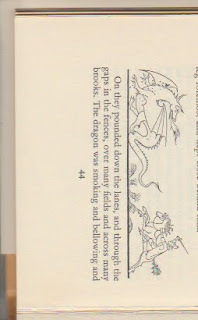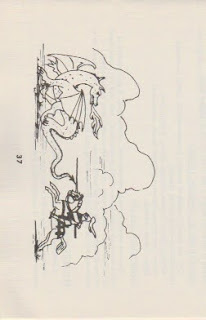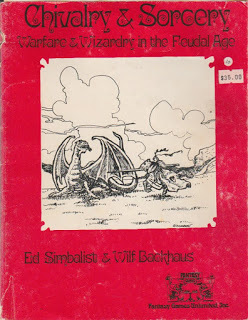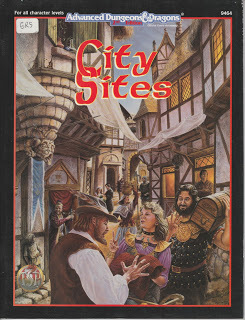John D. Rateliff's Blog, page 55
September 20, 2020
The Centre for Fantasy
So the best news I heard this past week was the announcement of the establishment of The Centre for Fantasy and the Fantastic, a center for fantasy studies at the University of Glasgow, which offers a MLitt in fantasy.
Here's a great short piece by Dimitra Fimi giving an overview of the Centre's goals and planned activities:
https://www.facebook.com/UofGlasgow/videos/443272223277326
They launched the new programme with a 'webinare' event: a lecture by Ellen Kushner and panel discussion by Terry Windling, Brian Attebery, and Rbt Maslen:
https://fantasy.glasgow.ac.uk/?fbclid=IwAR35D_3k1H1goEyPguc72pfLZYU1TnsJpBaLs48I-puECv-swhzLWnWTE5A
A general overview of the Centre's planned activities --"the world's first research centre focusing purely on the fantasy genre . . . everything from the works of J. R. R. Tolkien to Dungeons & Dragons and Game of Thrones"--can be found here:
I was particularly interested in the requirements for the degree, as detailed under "Programme Structure" in the following link:
https://www.gla.ac.uk/postgraduate/taught/fantasy/#whythisprogramme,programmestructure
Looking at this, I'm immediately curious over the break-point between their two survey courses, Fantasy from 1780 to 1950 (Part I) and Fantasy from 1950 to Present (Part II). If I were to get the chance to take such a course the third topic I'd probably have gone for wd be either "Children's Fantasy Literature" (the distinction between fantasy for younger readers and for adults being a permeable one) and "Early Modern Mythmaking".
It's also exciting to know that dissertations are currently in the works on Terry Pratchett (the first person knighted for writing fantasy), stage-plays based on fantasy novels (which I assume will cover things like the popular adaptation of Pullman's HIS DARK MATERIALS and perhaps the LotR musical) and Tolkien as seen by younger readers.
I have to confess found myself wistful, thinking about what might have been had there been an option like this one back in 1981 when I was wrapping up at Fayetteville and looking around for someplace where I cd work on a doctorate while continuing my Tolkien studies. As it turned out, it was like pursuing two courses of research at the same time -- which is probably one reason it took me so long.
For all of those of us who were discouraged (to put it mildly) from researching Tolkien, and for those like Verlyn Flieger and Douglass Parker who found a way to teach such courses despite lack of departmental support (and sometimes downright disapproval), this is a great day.
--John R.
--current reading: THE LAST TSAR, the new Woodward book, a light novel
September 12, 2020
Yellow Sky
Waking up this morning I saw that the sky was yellow-grey, and thought today's theme song wd be Sting's "Wild Wild Sea/The Soul Cages" with its lines "pale yellow sky" and "the sky was the color of clay." Except that it's more like the color of hay, like walking around inside an old sepia photograph.
All this is of course the result of smoke --not just from the fires down in California and Oregon and eastern Washington but closer to home, in neighboring towns on the outskirts of the Seattle area such as Sumner and Bonnie Lake (about fourteen and twenty miles from here, respectively).
It's alarming to have to stay in because the air quality's so bad but things cd be much much worse.
The cats, for their part, know something is up and are staying close to us, keeping an eye on what we're doing, when not prowling about.
--John R.
September 11, 2020
A Warning to the source study-ist
So, I've been reading David Lindsay's DEVIL'S TOR (1932), the last book he published in his lifetime. I'd read it before during my grad school days at Marquette --say 1984 or thereabouts-- but found I've more or less completely forgotten its contents. So I was bemused by the following passage from Chapter VII:
The torch in hitting the ground had escaped from his hand, so, staying down, he began to grope for it, but could not immediately find it. Then, as he proceeded to crawl here and there with lightly feeling fingers, they encountered something else small and hard on the rock floor, which was not the torch. Doubtless it was some tomb treasure that he had overlooked—it surely felt like a precious stone or talisman, half-round, half-flat. Out of the question it was to examine it there and then, so he slipped the thing into his coat pocket. A moment later the torch met his fingers.
Taken out of context, it'd be tempting to make the argument that this scene had some influence on the famous scene in THE HOBBIT (Chapter V) where Bilbo finds himself alone in the dark far below the surface. And we do know that Tolkien read Lindsay (albeit a different book, 1920's A VOYAGE TO ARCTURUS).
Except that it all breaks down as soon as we look at the context: we know from the dating that the two books were being written concurrently and it’s impossible for either to have been influenced by the other. It's good to be reminded that sometimes similar circumstances produce similar scenes --cf. Edgar Poe's "The Pit & the Pendulum" anyone?
—John R.--current reading: DEVIL'S TOR and the latest 'Royal Spyness' mystery, along with some other long-read on-again/off-again works.current music: McGear (1974)
August 29, 2020
Tolkien's influence on D&D art
So, here's something I noticed years ago but haven't ever seen commented on, so I thought I'd share.
Setting aside the many borrowings from THE HOBBIT and THE LORD OF THE RINGS in D&D, there's also evidence that Tolkien's short work FARMER GILES OF HAM (1949) influenced D&D.
In a way this shd not be surprising -- in fact, I cd make a case that in plot FGH is more like a D&D adventure than either of Tolkien's major works available at the time. I think the borrowing has gone unnoticed because it's art, not text.
Here's a picture by Pauline Baynes of Tolkien's reluctant hero chasing a dragon (FGH page 44).

And here's a strangely familiar illo from CHAINMAIL (3rd edition, page 37), the work that preceded the first edition of D&D; the core that D&D grew out of.

Comparison between the two shows that the figure of the dragon in each are so similar that the later one might well be tracing.
But it doesn't end there. Take a look at the cover of CHIVALRY & SORCERY (1977), one of the first-generation D&D derivatives (along with TUNNELS & TROLLS, RUNEQUEST, ROLEMASTER, &c).*
 Granted here we have similarity rather than direct copying, but I think the resemblance is striking. And partly due I suspect to the C&S artist basing his work on the CHAINMAIL art, not having seen the Tolkienian original.
Granted here we have similarity rather than direct copying, but I think the resemblance is striking. And partly due I suspect to the C&S artist basing his work on the CHAINMAIL art, not having seen the Tolkienian original.--John R.--current reading: THE LAST TSAR 1992
*Of these, CHIVALRY & SORCERY was notable for its appeal to those who wanted their fantasy roleplaying as realistic as possible. It's no surprise its title page bears a dedication to the Society of Creative Anachronism.
August 23, 2020
TSR Faces, 1994

Front left: unidentified.
Front central: Sue Weinlein.
Front right: Dave Wise
center left: Jeff Grubb (with fez).
center, with basket: unidentified
center right, in doorway: Skip Williams
back left: Wolfgang Baur, talking to unidentified (?Ann Brown)
back right, with halberd: unidentified.
In the distance, waving at us: Zeb Cook, who had just left TSR, bidding us farewell after his epic fourteen-year run.*
--John R.
*which ended on a high note, with his creation of PLANESCAPE.
August 22, 2020
a RAVENLOFT 'LIVING DEATH' recommended reading list (1995)
Here's a piece I created long ago that I was glad to come across again: a listing of stories, mostly from the period 1890 though 1914, for DMs wishing to create their own adventures set in Gothic Earth. I wanted to be respectful of WotC's copyright, so I have cut the commentary and here give just the listing. Those wishing to see the whole piece can find it in POLYHEDRON #112, the October 1995 issue, pages 11-13.
. . . On Life, On Death . . .Recommended Reading for the LIVING DEATH Campaign
William Hope HodgsonCarnacki the Ghost Finder (1914), Esp. "The Gateway of the Monster" and "The Whistling Room" See also the novel The Ghost Pirates (1909) & the short stories "The Voice in the Fog" and "The Derelict".
M. R. JamesGhost Stories of an Antiquary (1904)More Ghost Stories (1911)A Thin Ghost and Others (1919)A Warning to the Curious (1925) Esp. "Oh Whistle & I'll Come to You, My Lad", "The Tractate Middoth", "Casting the Runes". Also worthy of attention: "The Mezzotint", Mr. Humphreys and his Inheritance", "A Neighbor's Landmark", "A View From a Hill", and "A Warning to the Curious".
The Master: Edgar Poe"The Facts in the Case of M. Valdemar", "The Fall of the House of Usher", "A Tale of the Ragged Mountains", "Ms. Found in a Bottle", "The Lighthouse" (unfinished), "William Wilson", "The Pit & the Pendulum", "The Premature Burial", "The Masque of the Red Death", "Silence", "The Tell-Tales Heart", "The System of Doctor Tarr & Professor Fether", The Cask of Amontillado", and The Adventures of A. Gordon Pym (1838).
Bram StokerDracula (1897) Also "The Burial of the Rats" and "Dracula's Guest".
R. W. ChambersThe King in Yellow, esp. "The Yellow Sign" (1895).
W. B. Yeats"Rosa Alchemica", "The Tables of the Law", & "The Adoration of the Magi" (1897).
Algernon BlackwoodJohn Silence (1908). Also "The Listener", "The Empty House", "The Willows", "The Wendigo", and many others.
Arthur Machan"The Novel of the White Powder" (from The Three Imposters,1895).
Ambrose Bierce"The Damned Thing", "An Occurrence at Owl Creek Bridge", "An Inhabitant of Carcosa", "The Suitable Surroundings", "The Middle Toe of the Right Foot", "Mysterious Disappearances", "The Moonlit Road", "The Stranger".
Sheridan LeFanu"Green Tea", "The Murdered Cousin", "Carmilla".
Henry James"The Turn of the Screw" (1898) & "The Jolly Corner" (1908).
Charlotte Perkins Gilman"The Yellow Wallpaper" (1892).
Clark Ashton Smith"Genius Loci" (1933).
H. P. LovecraftThe Case of Charles Dexter Ward (1927).
Lord Dunsany"The Bureau de Exchange du Maux", "The Field", "The Highwayman", "Where the Tides Ebb and Flow", "The Ghosts", "How Nuth Would Have Practised His Art upon the Gnoles", "The Hashish Man", "A Narrow Escape", "The Kith of the Elf-Folk", "Poor Old Bill", "The Wonderful Window", "Taking Up Piccadilly", "The Sphinx in Thebes (Massachusetts)", "The Trouble in Leafy Green Street", "Lobster Salad", "The Three Infernal Jokes", "The Return", "The Old Brown Coat", and "By Night in the Forest". See also the play A Night at An Inn (1916).
Robert Lewis StevensonThe Case of Dr. Jekyll and Mr. Hyde (1886).
Nonfiction R. A. Gilbert The Golden Dawn: Twilight of Magicians (1983).
Recent, but Still Worthy Robert ArthurGhosts and More Ghosts (1963) Esp. "Footsteps Invisible", "Do You Believe in Ghosts?", "Obstinate Uncle Otis", & "Mr. Dexter's Dragon".
John BellairsThe Face in the Frost (1969).
Barbara HamblyThose Who Hunt the Night (1988).
Jonathan CarrollThe Land of Laughs (1980).
Roger ZelaznyA Night in Lonesome October (1993).
--I ended with a brief note about why Mary Shelly, Gaston Leroux, and Stephen King were not included.
While I'm thinking about the MASK OF THE RED DEATH setting, I also wrote a scenario ('The Lost Valley') for one of the LIVING DEATH tournaments (GenCon 1996 I think). I'm hoping this turns up as well, since I was quite fond of it at the time, though it's been many years since I've seen it.
--John R.--who ran a CALL OF CTHULHU session recently based on Robert Arthur's "Do You Believe in Ghosts?" which went v. well.
August 21, 2020
Richard Adams' private fantasy world
So, in my recently dipping into Richard Adams' autobiography* I was surprised to learn that he was one of those people who as a child made up his own private fantasy world. Shirley Jackson was another, and we know that when her daughter showed an interest in writing Jackson encouraged her to create her own such fantasy world. One of the more famous of such twentieth century efforts is BOXON, created by the Lewis Brothers, while Eddison was already writing about characters and events from what came to be THE WORM OUROBOROS when he was ten. And we know that all four of Tolkien's children had his or her own world, each of which took the form of an island (John's island had lots of trains, while Priscilla's was apparently populated entirely by stuffed bears).
Yet what I found unexpected in Adams' account is that he not only kept up his fantasy world at least well into college but that his example led to several of his fellow students revealing that they too had private worlds. Like Tolkien's suspicion that there were more people than you'd think who exercise the 'private vice' of creating their own language, Adams's experience suggests there were similarly quite a few who had their own private worlds.
Here's Adams account: I've quoted the full passage to help establish the context, which begins with his singling out the things that were most important to him at Oxford.
". . . my imaginative life, which was in certain respects more real to me than reality.
"I had always had a lot of fantasy in my life — as far back as I could remember. Once it had been the kingdom of Bull Bands, its halls and state rooms secluded among the laurels; a land-locked realm, deriving its attributes largely from King Arthur and peopled with knights, whose enemies were foxes. Later, at Horris Hill and unde the influence of films and writers like Sapper and Dornford Yates, Bull Banks had become a gay, fashionable city-state of sport and pleasure, its celebrities, my companions, forever playing cricket or football matches or dancing in champagne-flowing night clubs (like those of Ralph Lynn and Winifred Shotter; Bertie Wooster; Marlene Dietrich). At Horris Hall I had found that this Bull Banks carried so much conviction and included so much detail that other boys revealed their own fantasy countries (and one or two, I suspect, hastened to invent them). A few years ago, walking along the Embankment by Charing Cross, I ran into a friend from those days, and as we chatted, recalled those kingdoms — his and mine. 'Ah,' he said, 'but you had the ends much better tied up than I did.' Certainly a great deal of my time and mental energy went into the fantasies, which in my infancy compensated for solitude and at boarding-school for boring features like Mr Morris and Mr Arnold.
"Not the least of the wonderful things about Oxford was that it happily accepted and took on board your fantasy potential — whoever would have thought it? — developed and transformed it, blending it with magic oils, with sounds and sweet airs that gave delight and hurt not. Christopher Isherwood found exactly this at Cambridge, and wrote about it in his autobiographical Lions and Shadows. Alasdair, like Isherwood's friend Chalmers ('Already the crowds begin —'), would find phrases suggesting themselves as we listened to music. I recall how we derived, as surely as ever did Swann from the 'petite phrasee' of Vinteuil, a peculiar and personal meaning from the Leonora No. 3. (Alasdair used to sing, 'I think, he soon, will really be quite free.')
Indeed music was the great, the principal releasing agent, acting like some miraculous catalyst to bring upon us trance and ecstasy . . . "
—Richard Adams, THE DAY GONE BY (1990), page 228
Of course there are many world-creators who do their creating primarily as adults: Tolkien himself being the most famous modern example, but Austin Tappen Wright and Cordwainer Smith fit the pattern as well. I suspect most people with such propensities these days scratch that itch by playing D&D.
--John R.
*which covers the first half of his life, to the days just following World War II
August 20, 2020
God bless Google
So, the day before yesterday I had a line from a song I cdn't identify stuck in my head all evening. Usually with such things I just have to give it time and over the course of a day or so the snippet will stretch to include a few words or notes to either side of the bit I have. This time it didn't seem to be making any progress, so before the morning was over I'd typed in the line I had and Google's lyrics-searching did the rest.
For the record, the line was
does your head ever give you trouble
And, for those who want to guess it on their own, I've moved the answer to comments.
--John R.--current listening: that song and also THE CONCERT FOR BANGLA DESH, which I'd never heard until last week. Essentially a live version of George Harrison's ALL THINGS MUST PASS, the high water mark of his solo career.
The New Arrival: Flieger's ARTHURIAN VOICES
So, last week brought a pleasant surprise: the arrival in the mail of Verlyn Flieger's new book (always a good thing): ARTHURIAN VOICES. This is a collection bringing together two independent but related works: AVILION and THE BARGAIN.* The first retells LE MORTE D'ARTHUR, the second SIR GAWAIN & THE GREEN KNIGHT. I contributed a back-cover blurb, which reads as follows:
In Avilion, Verlyn Flieger brings to life the personae of the Arthurian legend, specifically those in the works of Sir Thomas Malory. She offers the chance to hear the familiar story anew, giving the characters, major and minor, a chance to speak in their own distinctive voices. Out of a mosaic of perspectives emerges a heartbreakingly believable array of tales, as each character tells the story as it appeared to him or (significantly) her.
If Malory is the first of the great Modern English Arthurians, the Gawain-poet is the last of the great Middle English Arthurians. In The Bargain, Verlyn Flieger takes us behind the scenes and into the heads of the cast of Sir Gawain & the Green Knight, one of the most subtle of the great medieval Arthurian tales.
To this shd be added this evaluation by Arthurian scholar Richard West in his Preface to the work
In Avilion Flieger has brilliantly retold the life of King Arthur in short compass in the multiple voices and viewpoints of major characters in the legend. In The Bargain she delightfully recasts a single adventure of one of Arthur'snephews and knights in dramatic dialogue . . . Prepare to be entertained.
--John R.--current reading: Lindsay's A VOYAGE TO ARCTURUS, Adams' GIRL IN A SWING, Garth's THE WORLDS OF J. R. R. TOLKIEN, and much misc. matter.
*which I always think of by its original title, MR. GREEN
August 19, 2020
Tolkien Enterprises Again
In a page headed "In Brief" devoted to short news items (mostly updates about forthcoming releases), one of the ten items reads as follows:
TOLKIEN ENTERPRISES
A recent advert placed in 'YOU' magazine offered for sale a limited
edition range of pewter characters from The Lord of the Rings. We are
advised by Tolkien Enterprises that this line of "Lord of the Rings"
pewter figurines offered for sale by Shire Evocations is unauthorised by
Tolkien Enterprises. The Tolkien Estate has granted Tolkien Enterprises
the sole right for quality control and licensing of merchandise based on
J. R. R. Tolkien's works The Hobbit and The Lord of the Rings. Watch
this space for further developments!
This offers a good example of Tolkien Enterprises presenting itself as if it were acting on behalf of Tolkien's heirs, when a close reading of the announcement shows they've only suggested this. No wonder people got the two (Tolkien Estate/Tolkien Enterprises) confused and never realized they were separate entities with diametrically opposed goals.
--John R.
--current reading: skimming a lot of old modules (D&D and C.o.C.). Some of them hold up really well; others have mainly nostalgia value. It's rather like classic rock, which I listen to all the time: mostly what I liked back then I still like now, and what I didn't I don't. I'm currently playing through MASKS OF NYARLATHOTEP for the first time and am looking forward to reading it once the game eventually wraps up (which cd come sooner than we think, in our most recent session we came perilously cloose to the dreaded t.p.k.)
John D. Rateliff's Blog
- John D. Rateliff's profile
- 38 followers



